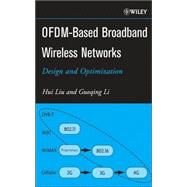
Note: Supplemental materials are not guaranteed with Rental or Used book purchases.
Purchase Benefits
Looking to rent a book? Rent OFDM-Based Broadband Wireless Networks Design and Optimization [ISBN: 9780471723462] for the semester, quarter, and short term or search our site for other textbooks by Liu, Hui; Li, Guoqing. Renting a textbook can save you up to 90% from the cost of buying.
GUOQING LI, PhD, is a Research Scientist in the Communication Technology Lab of Intel, where she works on broadband wireless technologies. Previously, Dr. Li worked as a senior system engineer at UTStarcom, developing algorithms for physical, multiple access control, radio link control, and radio resource control layers for 3G-WCDMA and IS-95 networks. Dr. Li has published more than twenty journal articles and conference papers.
| Preface | xi | ||||
|
1 | (12) | |||
|
1 | (5) | |||
|
2 | (1) | |||
|
3 | (2) | |||
|
5 | (1) | |||
|
6 | (3) | |||
|
9 | (4) | |||
|
11 | (2) | |||
|
13 | (18) | |||
|
13 | (6) | |||
|
14 | (1) | |||
|
15 | (1) | |||
|
16 | (1) | |||
|
17 | (2) | |||
|
19 | (5) | |||
|
24 | (4) | |||
|
28 | (3) | |||
|
29 | (2) | |||
|
31 | (36) | |||
|
31 | (7) | |||
|
32 | (1) | |||
|
33 | (1) | |||
|
34 | (4) | |||
|
38 | (8) | |||
|
38 | (2) | |||
|
40 | (2) | |||
|
42 | (4) | |||
|
46 | (9) | |||
|
47 | (1) | |||
|
48 | (2) | |||
|
50 | (5) | |||
|
55 | (8) | |||
|
57 | (2) | |||
|
59 | (2) | |||
|
61 | (1) | |||
|
61 | (2) | |||
|
63 | (4) | |||
|
63 | (4) | |||
|
67 | (33) | |||
|
67 | (3) | |||
|
70 | (5) | |||
|
70 | (1) | |||
|
71 | (1) | |||
|
71 | (2) | |||
|
73 | (1) | |||
|
74 | (1) | |||
|
75 | (5) | |||
|
80 | (5) | |||
|
80 | (1) | |||
|
81 | (1) | |||
|
82 | (1) | |||
|
83 | (2) | |||
|
85 | (1) | |||
|
85 | (8) | |||
|
85 | (2) | |||
|
87 | (3) | |||
|
90 | (3) | |||
|
93 | (7) | |||
|
97 | (1) | |||
|
97 | (1) | |||
|
97 | (1) | |||
|
97 | (3) | |||
|
100 | (38) | |||
|
100 | (1) | |||
|
100 | (6) | |||
|
100 | (2) | |||
|
102 | (4) | |||
|
106 | (3) | |||
|
109 | (7) | |||
|
116 | (17) | |||
|
117 | (7) | |||
|
124 | (9) | |||
|
133 | (5) | |||
|
134 | (1) | |||
|
134 | (1) | |||
|
134 | (4) | |||
|
138 | (28) | |||
|
138 | (2) | |||
|
140 | (19) | |||
|
140 | (1) | |||
|
141 | (2) | |||
|
143 | (11) | |||
|
154 | (5) | |||
|
159 | (4) | |||
|
163 | (3) | |||
|
163 | (3) | |||
|
166 | (25) | |||
|
166 | (4) | |||
|
167 | (2) | |||
|
169 | (1) | |||
|
170 | (10) | |||
|
171 | (3) | |||
|
174 | (2) | |||
|
176 | (1) | |||
|
177 | (2) | |||
|
179 | (1) | |||
|
180 | (6) | |||
|
181 | (3) | |||
|
184 | (2) | |||
|
186 | (5) | |||
|
188 | (3) | |||
|
191 | (51) | |||
|
191 | (21) | |||
|
191 | (2) | |||
|
193 | (3) | |||
|
196 | (9) | |||
|
205 | (7) | |||
|
212 | (21) | |||
|
214 | (1) | |||
|
214 | (13) | |||
|
227 | (6) | |||
|
233 | (9) | |||
|
233 | (1) | |||
|
234 | (5) | |||
|
239 | (3) | |||
| Notations, Acronyms and Commonly Used Symbols | 242 | (4) | |||
| About the Authors | 246 | (2) | |||
| Index | 248 |
The New copy of this book will include any supplemental materials advertised. Please check the title of the book to determine if it should include any access cards, study guides, lab manuals, CDs, etc.
The Used, Rental and eBook copies of this book are not guaranteed to include any supplemental materials. Typically, only the book itself is included. This is true even if the title states it includes any access cards, study guides, lab manuals, CDs, etc.